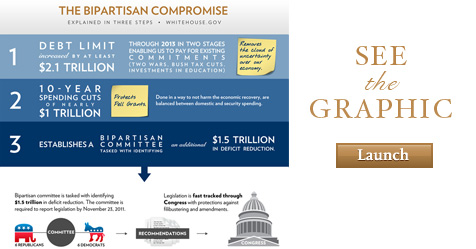
Tuesday’s budget compromise creates a joint committee of Congress, which you might have seen referred to as the “super committee.” This committee is responsible for developing a bipartisan plan for reducing our deficit by $1.5 trillion over the next 10 years. (That’s on top of about $1 trillion from the down payment that was included in the first phase of the deal.)
At the White House Office of Public Engagement, we’ve been getting a lot of questions about exactly how the joint committee will work. We've created an infographic that illustrates the process, but I’d also like to answer a few of those questions below.
Q: Who’s on the joint committee?
A: Six Democrats, and six Republicans. Each of four party leaders in Congress will choose three members of the committee, so half will come from the House, and half from the Senate.
Q: As the joint committee comes up with a plan, what’s on the table?
A: Everything. The joint committee has no restrictions on where it can find ways to reduce our deficit. It can eliminate tax loopholes, just like it can cut spending. President Obama believes that the committee should listen to the vast majority of Americans who support a balanced approach that includes revenue.
Q: The first round of deficit reduction was made up entirely of spending cuts. Will the second round be as well?
A: The short answer is no. The Committee can look at the entire budget including revenue and entitlements. And the President has made it clear that he will only accept a balanced approach.
Q: Republicans have refused to support a balanced approach in the past. Why would they support one now?
A: The threat of allowing our nation to default gave Republicans a lot of leverage in the first round of negotiations. In the second round, that changes. First, if the joint committee doesn’t come up with the kind of approach both parties can support, it sets up a “trigger,” something Democrats and Republicans both want to avoid. (I’ll explain the trigger in more detail below.)
Second, the Bush high-income tax cuts are set to expire on January 1, 2013. This forces Congress to deal with this issue, and if Congress does vote to extend these special tax breaks, the President can use his veto pen to end them. This gives Republicans added incentive to compromise on an approach that balances spending reductions and closing tax loopholes.
Q: When the joint committee comes up with its plan, what happens next?
A: If seven out of the 12 members of the joint committee approve a plan, it moves to a straight up-or-down vote in Congress. No filibusters, no amendments, and no procedural tricks. If Congress approves the plan, and President Obama signs it, it goes into law.
Q: What happens if the joint committee can’t reach a deficit reduction agreement that passes Congress?
A: If the joint committee can’t come up with a plan that the Senate, the House, and President Obama can all approve by January 15, 2012, it automatically sets off what’s known as a “trigger.” This trigger puts pressure on both sides to compromise, because it would make cuts that would be painful for Democrats and Republicans alike – half the cuts would come from domestic programs, and half from defense.
However, President Obama made sure that Medicaid, Social Security, and Medicare benefits would not be cut in the event that the trigger is set off. Neither would programs for the most vulnerable, such as food stamps and the Earned Income Tax Credit.
Q: The President says he wants to see a balanced approach. What exactly does that look like?
A: A balanced approach means that everything is on the table, and everyone pays their fair share. This could include reforms to programs like Medicare, so they will be around for the next generation. But that would also require asking the most fortunate to do their part: closing loopholes in the tax code, ending wasteful subsidies to corporations, and asking millionaires and billionaires to pay their fair share.
Polls have consistently shown that the majority of Americans support the President’s call for balance and compromise.
Q: What can I do to make a difference?
A: During this debate, President Obama asked the American people to urgeWashington to put partisanship aside, and make the tough choices that are best for the country. Your voice made a huge difference in protecting programs like Medicaid, Medicare, and Social Security during the first stage of this deal.
If you agree with President Obama – if you support a balanced approach – don’t stay silent on this issue. If you want to see Washington compromise, put politics aside, and ask all Americans to pay their fair share – then make your voice heard.
And stay in touch with the Office of Public Engagement! Visit Whitehouse.gov/engage to learn how Americans from all over the country are changing the way Washington does business, both in this debate, and on a wide variety of other issues.
Related: Jon Carson addresses the myths and facts about the debt-ceiling compromise



